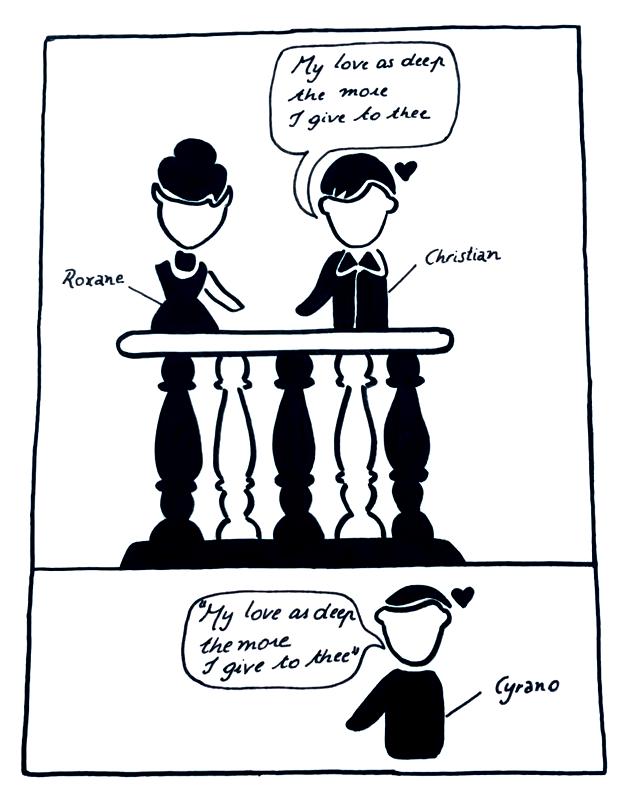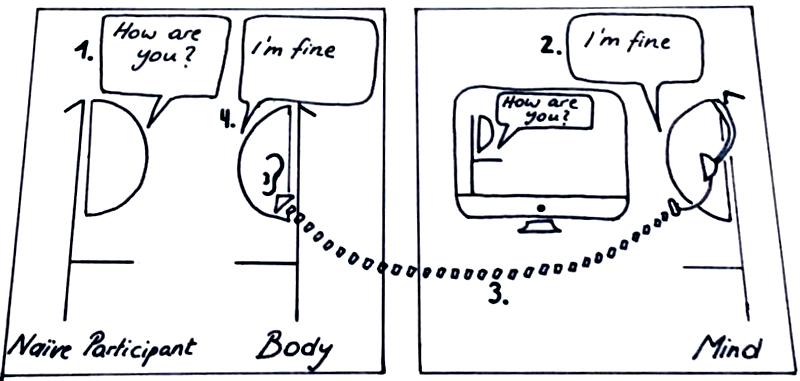The cyranoid method:
An unorthodox experiment

Cyrano & Christian 💘 Roxane
In Edmund Rostand’s play “Cyrano de Bergerac”, the inarticulate yet handsome nobleman Christian seeks to conquer the heart of Roxane by speaking to her the words of Cyrano, a talented yet ugly poet.
While Christian and Roxane stand on the balcony, Cyrano hides underneath in the shadow and whispers his words to Christian. Christian repeats Cyrano’s prose – word for word – to impress Roxane. Cyrano is himself unhappily in love with Roxane, yet he succeeds in charming her – so to speak – through the body of Christian.

Milgram’s cyranoid method
In reference to Cyrano, social psychologist Stanley Milgram (famous for his controversial ‘obedience to authority experiment’) invented the term “cyranoid” and developed a new, unorthodox experimental method for studying person perception:
the cyranoid method
Rostand’s play illustrates the fusion of separate body and mind that is central to Milgram’s cyranoid method. The two men succeed in conquering Roxane’s heart through a clever trick: They combine Christian’s body (his beautiful physical appearance) with Cyrano’s mind (his eloquence). The result is a “hybrid social persona” that Milgram named “cyranoid”.
What is a cyranoid?
Speaking in Milgram’s jargon, a cyranoid consists of two separate individuals named shadower (=’the body’) and source (=’the mind’). The source (=’mind’) speaks words or sentences that the shadower (=’body’) instantaneously repeats. This vocal technique is called speech shadowing.
To keep it as simple as possible, I will refer to the two individuals as body and mind in what follows.
The definition I just gave you is still a bit shadowy.
How does all of this exactly work? Let’s break the experiment down into separate pieces.
Speech shadowing
This is a vocal technique whereby an individual (here: the body) listens through an electronic device to speech produced by another individual hidden in a separate room (here: the mind) and repeats it word for word with shortest possible delay.
The aim is to make it appear as natural and authentic as possible, as if the body actually spoke autonomous, self-authored words. In order to achieve this aim – and not to arouse suspicion – the individual who speech shadows (i.e. the body) wears a hidden ear piece which allows him/her to listen to the mind’s voice. The ear piece is very tiny and skin-coloured, therefore not noticeable to the bare naked eye.
Time to bring in naïve participants
In this unorthodox experimental set-up, naïve participants are then put in a face-to-face conversation with the body. They see his/her physical appearance but the words they hear him/her speak are actually originated by a hidden person (the mind) in a hidden back room.

The participants are “naïve” as the experiment involves deception: The participants are led to believe that they are in a direct conversation with the person they see (the body), while in fact a third hidden person (the mind) is authoring the words that the body only reproduces in front of them.
The cyranic illusion
Milgram found that participants fall prey to this deception: they actually believe that the person they see speaks self-authored words, a phenomenon he termed “cyranic illusion”.
“Upon learning the true nature of the experiment, some participants ‘felt the loss of a person’, having had quite an engaging experience with their interlocutor, who, as it turned out, was merely a ‘synthetic creation of the experimental procedure and had no existence apart from the hybridisation which the experiment created’”
Milgram (1992, p. 340) cited by Corti & Gillespie (2015)
This suggests that when we encounter a new person face-to-face, we never question whether he/she actually speaks self-authored words – and for good reason – as social interaction would be rendered impossible if we constantly doubted the integrity of our conversation partners.
Inner vs Outer identity
The cyranoid method affords separating the inner identity (the mind) of a person from its outer or physical identity (the body) in a dynamic, interactive setting.
It allows to hold the person who plays the role of mind constant (keep it the same), and only to change the bodies that speak after him/her. By manipulating certain aspects of the body (for instance its gender or ethnicity) while still always keeping the same mind (who thinks and formulates sentences in the hidden back), it is possible to study whether participants form different impressions based on physical appearance/identity.
Time to state Hypotheses
H0= If physical appearance only played a s u b o r d i n a t e d role in impression formation, participants should in theory always make the same personality judgements, no matter the body they see (as it’s always the same person (with the same personality and same cognitive ability) that hides in the back and replies to them).
H1 = If participants make different personality judgements depending on the body they see (and it’s physical characteristics), this is evidence that physical appearance plays a d o m i n a n t role in impression formation.
Note: H0= Null Hypothesis= no relationship between physical appearance and impression H1= Alternative Hypothesis= relationship between physical appearance and impression
Time to test
Up next in this section: I tell you how I actually conducted the cyranoid experiment myself.
Stay tuned! 💗
or read meanwhile: From cyranic dreams to reality: A brief history of Milgram’s fascinating experiment
Written and published August 2019
by Jessica
List of references I used in this article:
Corti K. & Gillespie A. (2015) Revisiting Milgram’s Cyranoid Method: Experimenting With Hybrid Human Agents, The Journal of Social Psychology, 155:1, 30-56, DOI: 10.1080/00224545.2014.959885
Corti, K. (2015). Developing the Cyranoid Method of Mediated Interpersonal Communication in a Social Psychological Context: Applications in Person Perception, Human-computer Interaction, and First-person Research, PQDT – UK & Ireland.
Gillespie A and Corti K (2016) The Body That Speaks: Recombining Bodies and Speech Sources in Unscripted Face-to-Face Communication. Front. Psychol. 7:1300. doi: 10.3389/fpsyg.2016.01300
Marslen-Wilson, W. D. (1985). Speech shadowing and speech comprehension. Speech Communication, 4(1–3), 55–73.
Rostand, E. (1981). Cyrano de Bergerac (B. Hooker, Trans.). New York, NY: Bantam Books.